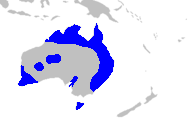
Xanthorrhoea is a genus of about 30 species of flowering plants endemic to Australia. Species are known by the name grass tree.

Kingia is a genus consisting of a single species, Kingia australis, and belongs to the plant family Dasypogonaceae. It has a thick pseudo-trunk consisting of accumulated leaf-bases, with a cluster of long, slender leaves on top. The trunk is usually unbranched, but can branch if the growing tip is damaged. Flowers occur in egg-shaped clusters on the ends of up to 100 long curved stems. Kingia grows extremely slowly, the trunk increasing in height by about 1½ centimetres per year. It can live for centuries, however, so can attain a substantial height; 400-year-old plants with a height of six metres are not unusual.

Angophora costata, commonly known as Sydney red gum or smooth-barked apple, is a species of medium-sized to tall tree that is endemic to eastern Australia. It has smooth bark, lance-shaped leaves arranged in opposite pairs, flower buds usually in groups of three, white or creamy white flowers and ribbed, oval or bell-shaped fruit.
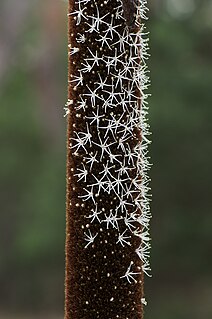
Xanthorrhoea australis, the grass tree, southern grasstree or austral grasstree, is an Australian plant. It is the most commonly seen species of the genus Xanthorrhoea. Its trunk can grow up to several metres tall and is often branched. In certain Aboriginal languages, it is called bukkup, baggup or kawee.

Eucalyptus tereticornis, commonly known as forest red gum, blue gum or red irongum, is a species of tree that is native to eastern Australia and southern New Guinea. It has smooth bark, lance-shaped to curved adult leaves, flower buds in groups of seven, nine or eleven, white flowers and hemispherical fruit.
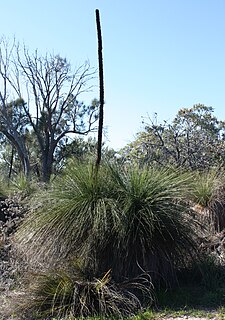
Xanthorrhoea preissii, known as balga, is a widespread species of perennial monocot in Southwest Australia.
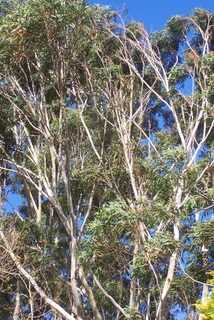
Eucalyptus pilularis, commonly known as blackbutt, is a species of medium-sized to tall tree that is endemic to eastern Australia. It has rough, finely fibrous greyish bark on the lower half of the trunk, smooth white, grey or cream-coloured bark above, lance-shaped to curved adult leaves, flower buds in groups of between seven and fifteen, white flowers and hemispherical or shortened spherical fruit.

Xanthorrhoea fulva is a species of grasstree of the genus Xanthorrhoea native to New South Wales and Queensland. It was previously regarded as a subspecies of Xanthorrhoea resinosa, but reclassified as a species in its own right in 1986.

Xanthorrhoea arborea a species of grasstree of the genus Xanthorrhoea native to New South Wales and Queensland. It was one of the many species authored by the Scottish botanist Robert Brown.

Xanthorrhoea minor is a species of grasstree of the genus Xanthorrhoea native to south-eastern Australia. It was one of the many species authored by the Scottish botanist Robert Brown.
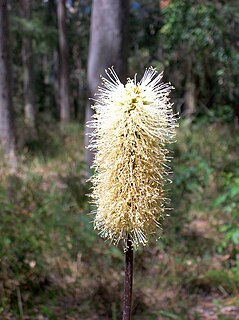
Xanthorrhoea macronema is a forest plant in the genus Xanthorrhoea, found in coastal regions of eastern Australia north of Sydney, New South Wales to Fraser Island, Queensland. The trunk of this grass tree is underground.

Xanthorrhoea glauca, known as the grass tree, is a large plant in the genus Xanthorrhoea, widespread in eastern Australia. The trunk can grow in excess of 5 metres tall, and may be many branched. It is occasionally seen in large communities in nutrient rich soils. The leaves are a grey or bluish glaucous green.

Xanthorrhoea resinosa, is known as one of the grass trees, a mid-sized plant in the genus Xanthorrhoea. The specific epithet is from the Latin, meaning “having resin”. This perennial shrub is found in heathland or eucalyptus forest.
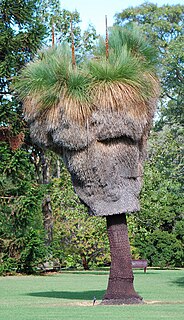
Xanthorrhoea malacophylla is a species of grasstree of the genus Xanthorrhoea. It is endemic to New South Wales, Australia. Mature plants form a single or branched trunk that ranges between 2 and 6 metres in height. The grass-like leaves, which are usually around 3 mm wide, are distinguished from other species by their softness and sponginess. The flowers appear between May and September in scapes that are between 1.3 and 1.8 metres long.

Persoonia media is a species of flowering plant in the family Proteaceae and is endemic to eastern Australia. It is an erect to spreading shrub or tree with branchlets and leaves that are glabrous or only sparsely hairy, elliptic to egg-shaped leaves and up to sixteen yellow flowers on a rachis up to 150 mm (5.9 in) long.

Xanthorrhoea drummondii, commonly known as blackboy, grasstree or Drummond's balga, is a species of grasstree of the genus Xanthorrhoea native to Western Australia.

Xanthorrhoea gracilis, commonly known as the graceful grasstree, grassboy or mimidi, is a species of grasstree of the genus Xanthorrhoea native to Western Australia.

Xanthorrhoea thorntonii, commonly known as Cundeelee grasstree, Cundeelee blackboy, desert grasstree, yacka or grasstree, is a species of grasstree of the genus Xanthorrhoea native to central Australia. It is known to the Pitjantjatjara people as kata-kultu, kata-puru, ulpa or urara, the Warlpiri people as yurlurnkuru and the Arrernte as lunkere. X. thorntonii is the only grass tree found in Central Australia including the Great Sandy Desert, Great Victoria Desert and MacDonnell Ranges.
Xanthorrhoea acaulis is a species of grasstree native to New South Wales, Australia.
Xanthorrhoea concava is a species of grasstree native to New South Wales, Australia.

















